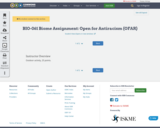
Outdoor activity, 25 points.
- Subject:
- Biology
- Material Type:
- Activity/Lab
- Author:
- Open for Antiracism Program (OFAR)
- Date Added:
- 09/27/2022

Outdoor activity, 25 points.
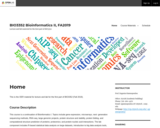
This course is a continuation of Bioinformatics I. Topics include gene expression, microarrays, next- generation sequencing methods, RNA-seq, large genomic projects, protein structure and stability, protein folding, and computational structure prediction of proteins; proteomics; and protein-nucleic acid interactions. The lab component includes R-based statistical data analysis on large datasets, introduction to big data analysis tools, protein visualization software, internet-based tools and high-level programming languages.
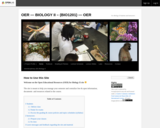
This site is an OER for BIology II and contains all the materials needed for the course including lecture slides and labs.

How can you tell if harmful bacteria are in your food or water that might make you sick? What you eat or drink can be contaminated with bacteria, viruses, parasites and toxins—pathogens that can be harmful or even fatal. Students learn which contaminants have the greatest health risks and how they enter the food supply. While food supply contaminants can be identified from cultures grown in labs, bioengineers are creating technologies to make the detection of contaminated food quicker, easier and more effective.

This is a great lab to do with students during October while most grocery stores stock dry ice for Halloween! Explore sublimation in action!
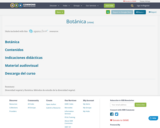
Diversidad vegetal y florística. Métodos de estudio de la diversidad vegetal.

Students will utilize previously gained knowledge about the impact of land management practices on ecosystems to design, conduct and analyze an experiment to measure biodiversity and/or invertebrate ecosystem role in a field community. They will identify ecosystems that have been heavily and lightly impacted by human activities and make predictions about biodiversity in the area. They will then test and analyze the information gathered and apply what this means about the biodiversity in these ecosystems and the implications this may have on the region.
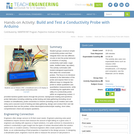
Student groups construct simple conductivity probes and then integrate them into two different circuits to test the probe behavior in solutions of varying conductivity (salt water, sugar water, distilled water, tap water). The activity culminates with student-designed experiments that utilize the constructed probes. The focus is to introduce students to the fabrication of the probe and expose them to two different ways to integrate the probe to obtain qualitative and quantitative measurements, while considering the application and utility of a conductivity probe within an engineering context. A provided handout guides teams through the process: background reading and questions; probe fabrication including soldering; probe testing and data gathering (including circuit creation on breadboard); probe connection to Arduino (including circuit creation and code entry) and a second round of testing and data gathering; design and conduct their own lab experiments that use the probes; online electrolyte/nonelectrolyte reading, short video, comprehension check and analysis questions.
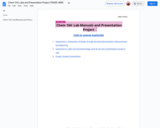
Includes two labratory assignments for Chemistry 104:
- Experiment 1: Exploration of Matter through Density Determinations: Measurement and Reporting
- Experiment 2: Light and Nanotechnology: How do we ‘See’ Something too Small to See?
And a presentation project for students.

During this single day lesson plan, students will be hypothesizing, preparing and comparing the usage of fats within baked products. Students will be asked to hypothesize the potential results of saturated versus unsaturated fats within a chocolate chip cookie recipe. Throughout the lesson, students will be completing a follow along lab packet. Said packet contains the following: lab plan/hypothesis sheet, recipe, lab notes sheet, and reflection sheet. This lesson may be completed within a single 55 minute class period or spread across two days to allow for extended preparation and reflection time (2 days suggested). Image Credit: OER Title Image Provided by Sorin Gheorghita | Unsplash
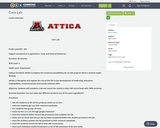
Corn Lab Grade Level:8th - 9thSubject: Introduction to Agriculture, Food, and Natural ResourcesDuration: 50 minutesDOK Level: 2SAMR Level: Substitution Indiana Standard: IAFNR-3.2 Explore the numerous possibilities for an SAE program which a student might developIAFNR-2.2 Recognize and explain the role of the FFA in the development of leadership, education, employability, communications and human relations skillsObjective: Students will complete a lab and record the results in their SAE record book with 100% accuracy. Essential Question: Can you make two different products out of the same ingredients?Procedure: Ask the students to list all the products made out of corn.Have the students get out their research notebooksPut students into groups of threeHand out the corn lab through google classroomHave the students follow normal lab procedures and complete the labMake sure to check that the pre lab has been completed before the student proceed to the labHave the students answer the lab questions in their research notebooksHave the students record the lab in their SAE record booksHave each individual student brainstorm a list of lab extensions to do next week.Product or Assessment: The students will be assessed on the lab questions answers in their research notebooks.
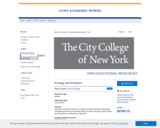
Introduction to the basic principles of ecology and evolutionary biology emphasizing quantitative approaches and hypothesis testing. Scientific reasoning, computer literacy, and writing skills are developed in the laboratory.

This is a learning "adventure" (i.e. interactive learning) for body tissues created for an Anatomy & Physiology 1 course. It can be modified for different concepts and is suitable for use in lecture, lab, or outside of class time as an independent assignment.
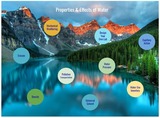
This lab allows students to explore some of the properties and effects of water. Students may choose from 9 options to complete 3 mini lab assignments. Each lab can be completed at home, with common household materials. The properties of mechanical weathering, erosion, density, transportation of pollution, pressure, water as a universal solvent and capillary action are included. Students also have the option to design their own experiment for a property of water of their choice. A water use inventory is also included to help students understand how much water is overused and how they can decrease water waste. The water use inventory is targeted at students in Utah, but can easily be adapted to any location.***Please have your students click "File" then "Make a Copy" to access each google doc. They will then be able to add their answers to their own copy.***

This is the lab manual for the Fay Lab at the University of Massachusetts Dartmouth School for Marine Science and Technology. The focus of our work centers around developing interdisciplinary modeling approaches to extend the scope of applications for fisheries and ecosystem-based management. More about our group’s research activity can be found on our website.
This lab manual resource is intended to provide an overview for lab members and others about how we do our work, and our expectations for our team. It is also a space to document institutional knowledge and for important information about procedures and available resources.
The content for this book was developed as part of our group’s participation in the Openscapes Champions program. We are extremely grateful to and acknowledge Dr. Julia Stewart Lowndes’ role in helping shape how our lab both works and how we articulate our identity. 🙏 Thanks also to Ileana Fenwick and Stefanie Butland for their work moving the lab-manual from bookdown to Quarto.
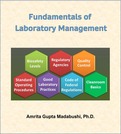
Fundamentals of Laboratory Management is designed to serve as an introductory guide to laboratory, quality and regulatory system in laboratories for biotechnicians.
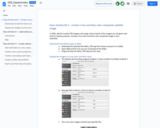
This guide walks you through three activities for students to complete:
Class Activity 3.2 – Create a true and false color composite satellite image.
Class Activity 5.1 – Label states and capitals in the northeastern US.
Class Activity 7.1 - Create a Bend-centered Equidistant Map Projection.

General Biology for Majors I Mohave College Lab Manual
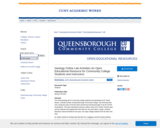
The online geology lab for community college students was developed by Dr. Rondi Davies, a faculty member at Queensborough Community College, City University New York, during two years of forced online synchronous learning brought on by the COVID-19 pandemic. This open educational resource collects many of Dr. Davies’ favorite open-access materials and supplements them with her own work within a single, cohesive laboratory manual intended for two-year, non-major college students from the New York area.
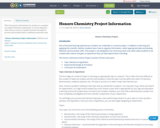
This is the project information for students to complete an original Chemistry experiment. It can be adapted to other areas in science. It guides students through the process and includes links to additional materials used.